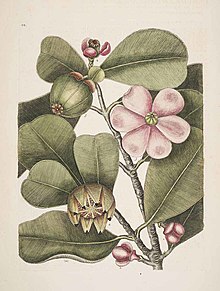Loading AI tools
Family of mainly tropical flowering plants From Wikipedia, the free encyclopedia
The Clusiaceae or Guttiferae Juss. (1789) (nom. alt. et cons. = alternative and valid name) are a family of plants including 13 genera and ca 750 species.[3] Several former members of Clusiacae are now placed in Calophyllaceae and Hypericaceae. They are mostly trees and shrubs,[4] with milky sap and fruits or capsules for seeds. The family is primarily tropical.[4] More so than many plant families, it shows large variation in plant morphology (for example, three to 10, fused or unfused petals, and many other traits).[4] According to the APG III, this family belongs to the order Malpighiales.
| Clusiaceae Temporal range: Possible Turonian record | |
|---|---|
 | |
| Clusia rosea | |
| Scientific classification | |
| Kingdom: | Plantae |
| Clade: | Tracheophytes |
| Clade: | Angiosperms |
| Clade: | Eudicots |
| Clade: | Rosids |
| Order: | Malpighiales |
| Family: | Clusiaceae Lindl.[2] |
| Type genus | |
| Clusia | |
| Synonyms | |
|
Guttiferae | |
One feature which is sometimes found in this family, and rarely in others (e.g., Malpighiaceae), is providing pollinators with "pollination rewards" other than pollen or nectar; specifically, some species offer resin, which certain bees use in nest construction (each Clusiaceae species offers only one type of reward).[4]
The family Clusiaceae was divided by Cronquist into two subfamilies: the Clusioideae (typical subfamily) and the Hypericoideae. The latter was often treated as a family—the Hypericaceae or St. John's wort family. Elements of the Hypericoideae are more common in northern temperate areas and those of the Clusioideae are centered in the tropics.
Later classifications, however, divide the family in a finer way. Molecular studies have shown that the family Podostemaceae—the riverweeds—as well as the Bonnetiaceae are nested in this group. Their inclusions make the Clusiaceae in a wide sense polyphyletic, and Stevens's subfamilies need to be recognised at family level: Clusioideae as Clusiaceae sensu stricto; Hypericoideae as Hypericaceae; and Kielmeyeroideae as Calophyllaceae.[5][6]



Following Ruhfel et al. (2011) [7]

Seamless Wikipedia browsing. On steroids.
Every time you click a link to Wikipedia, Wiktionary or Wikiquote in your browser's search results, it will show the modern Wikiwand interface.
Wikiwand extension is a five stars, simple, with minimum permission required to keep your browsing private, safe and transparent.